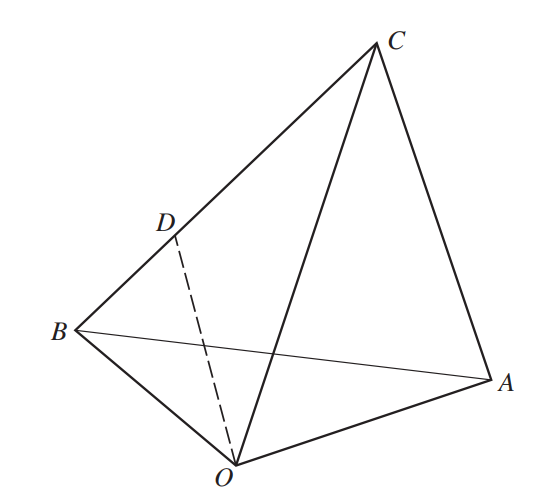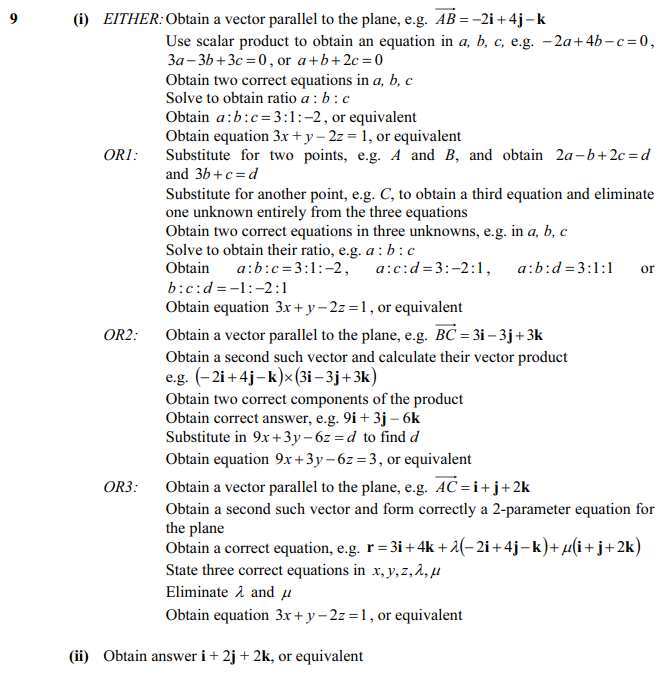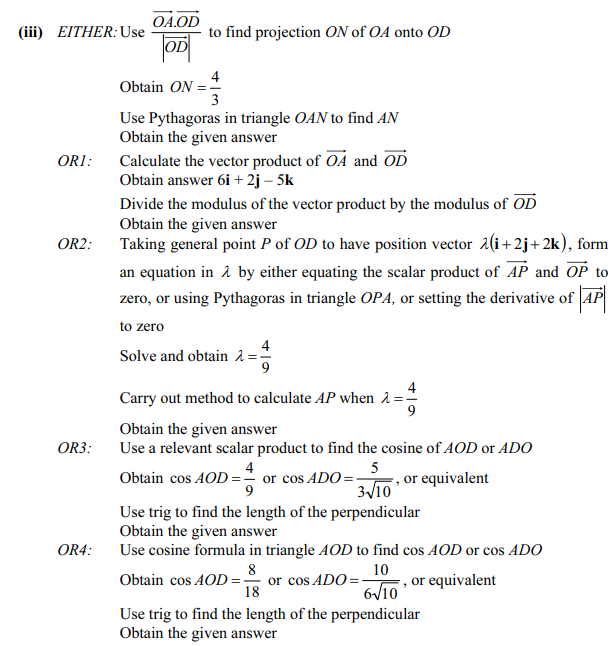Qurstion
The straight line l has equation r = 4i − j + 2k + , \(\lambda (2i− 3j + 6k)\). The plane p passes through the point( 4, −1, 2 )and is perpendicular to l.
(i) Find the equation of p, giving your answer in the form ax + by + cÏ = d.
(ii) Find the perpendicular distance from the origin to p.
(iii) A second plane q is parallel to p and the perpendicular distance between p and q is 14 units.
Find the possible equations of q.
Answer/Explanation
(i)
(i) Obtain 2x – 3y + 6z for LHS of equation
Obtain 2x – 3y + 6z = 23
(ii) Either Use correct formula to find perpendicular distance
Obtain unsimplified value \(frac{\pm 23}{\sqrt{2^{2}+(-3)^{2}+6^{2}}}\), following answer to (i)
Obtain \(\frac{23}{7}\)or equivalent
OR 1 Use scalar product of (4, –1, 2) and a vector normal to the plane
Use unit normal to plane to obtain\( \pm\frac{(8+3+12){\sqrt{49}}\)
Obtain distance\( \frac{23}{7}\) or equivalent
OR 2 Find parameter intersection of p and \(r=\mu (2i-3j+6k)\)
Obtain \(\mu =\frac{23}{49 }[and\left ( \frac{46}{49},-\frac{69}{49},\frac{138}{49} \right )\)as foot of perpendicular]
Obtain distance \(\frac{23}{7}\) or equivalent
(iii) Either Recognise that plane is 2x – 3y + 6z = k and attempt use of formula for
perpendicular distance to plane at least once
Obtain\( \frac{|23-k|}{7}=14 \) or equivalent
Obtain 2x – 3y + 6z = 121 and 2x – 3y + 6z = –75
OR Recognise that plane is 2x – 3y + 6z = k and attempt to find at least one
point on q using l with λ = ±2
Obtain 2x – 3y + 6z = 121
Obtain 2x – 3y + 6z = –75
Question

The diagram shows three points A, B and C whose position vectors with respect to the origin O are given by \(\underset{OA}{\rightarrow}=\begin{pmatrix}2\\-1\\2\\\end{pmatrix}, \underset{OB}{\rightarrow}=\begin{pmatrix}0\\3\\1\\\end{pmatrix}\) and \(\underset{OC}{\rightarrow}=\begin{pmatrix}3\\0\\4\\\end{pmatrix}\). The point D lies on BC, between B and C, and is such that CD = 2DB.
(i) Find the equation of the plane ABC, giving your answer in the form ax + by + cz = d. [6]
(ii) Find the position vector of D. [1]
(iii) Show that the length of the perpendicular from A to OD is \(\frac{1}{3}\sqrt{\left ( 65 \right )}\).[4]
Answer/Explanation
Ans:


Question
The points P and Q have position vectors, relative to the origin O, given by
\(\underset{OP}{\rightarrow}=7i+7j-5k\) and \(\underset{OQ}{\rightarrow}=5i+j+k.
The mid-point of PQ is the point A. The plane \(\mathbb{I}\) is perpendicular to the line PQ and passes through A.
(i) Find the equation of \(\mathbb{I}\), giving your answer in the form ax + by + cz = d. [4]
(ii) The straight line through P parallel to the x-axis meets \(\mathbb{I}\) at the point B. Find the distance AB, correct to 3 significant figures. [5]
Answer/Explanation
Ans:
(i) State or imply A is (1, 4, –2)
State or imply \(\underset{QP}{\rightarrow}=12i+6j-6k\) or equivalent
Use QP as normal and A as mid-point to find equation of plane
Obtain 12x + 6y – 6z = 48 or equivalent
(ii) Either State equation of PB is r = 7i + 7j – 5k + λi
Set up and solve a relevant equation for λ .
Obtain λ = −9 and hence B is (–2, 7, –5)
Use correct method to find distance between A and B.
Obtain 5.20
Or Obtain 12 for result of scalar product of QP and i or equivalent
Use correct method involving moduli, scalar product and cosine to find angle APB
Obtain 35.26° or equivalent
Use relevant trigonometry to find AB
Obtain 5.20
Question
The points A and B have position vectors 2i + j + k and i − 2j + 2k respectively. The line l has vector equation r = i + 2j − 3k + μ(i – 3j – 2k).
(a)Find a vector equation for the line through A and B.
(b) Find the acute angle between the directions of AB and l, giving your answer in degrees.
(c) Show that the line through A and B does not intersect the line l.
Answer/Explanation
Ans:
(a)Obtain direction vector −i− 3j+k
Use a correct method to form a vector equation
Obtain answer r = 2i + j + k + λ (-i-3j+k)
or r = i 2j + 2k + λ (-i-3j+k)
(b) Carry out the correct process for evaluating the scalar product of the direction vectors.
Using the correct process for the moduli, divide the scalar product by the product of the moduli and find the inverse cosine of the result for any 2 vectors
Obtain answer 61.1 °
(c)
Express general point of AB or l in component form, e.g. (2 –λ, 1 – 3λ, 1 + λ) or (1 + µ, 2 – 3 µ, – 3 – 2µ)
Equate at least two pairs of components and solve for λ or for µ
Obtain a correct answer for λ or µ, e.g. λ = \(= 6, \frac{1}{6}, or -\frac{14}{9}; \mu = -5, \frac{2}{3} or – \frac{11}{9}\)
Verify that all three equations are not satisfied, and the lines do not intersect
Express general point of AB or l in component form,
e.g. (1 –λ*,− 2 – 3λ*, 2 +λ*) or (1 + µ*, 2 – 3µ*, – 3 – 2µ*)
Question
With respect to the origin O, the points A, B, C, D have position vectors given by
\(\vec{OA}=i+3j+2k, \vec{OB}=2i+4j+k,\vec{OD}=-3i+j+2k\)
(i) Find the equation of the plane containing A, B and C, giving your answer in the form ax + by + cz = d.
(ii) The line through D parallel to OA meets the plane with equation x + 2y − z = 7 at the point P.
Find the position vector of P and show that the length of DP is\( 2\sqrt{14}\)
Answer/Explanation

(ii) Correctly form an equation for the line through D parallel to OA
Obtain a correct equation e.g \(r=-3i+j+2k+\lambda (i+3j+2k)\)
Substitute components in the equation of the plane and solve for λ
Obtain λ = 2 and position vector -i+7j+6k for p
Obtain the given answer correctly